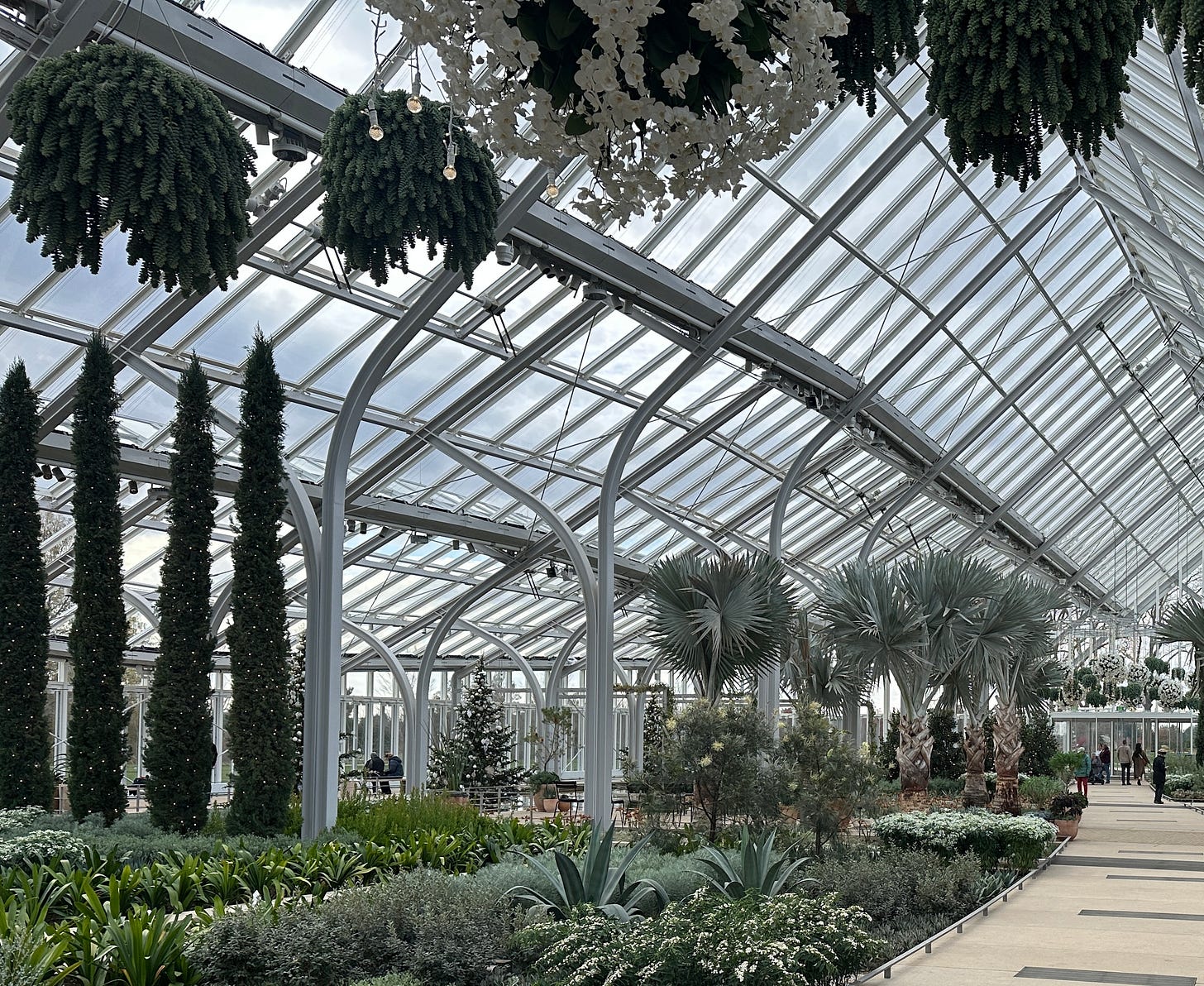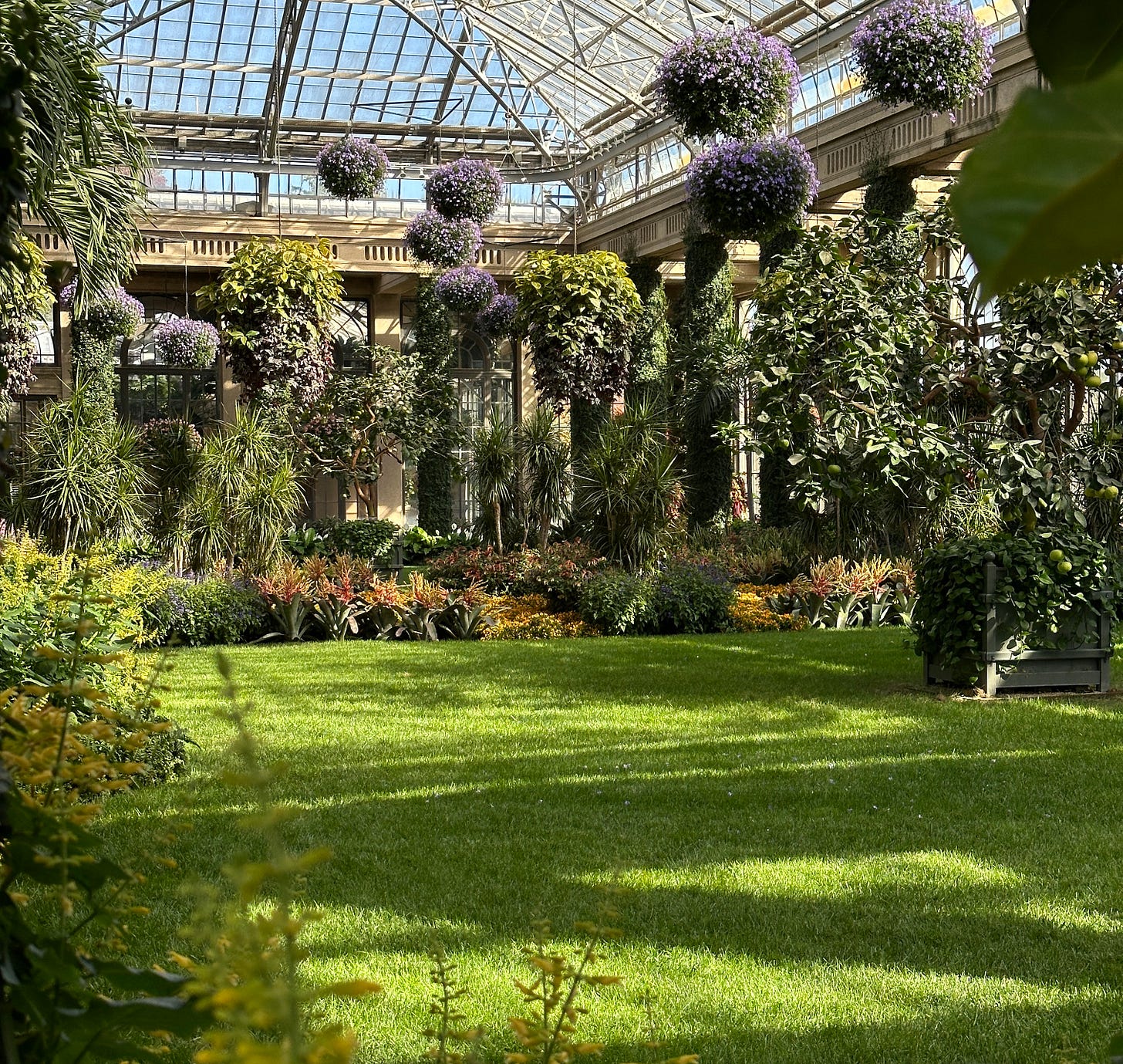One of America's Greatest Treasures Just Got a $250 Million Jewel
Plus, urban sketching, the potential demise of Clear, and Japan sex tourism.
If you ask people to name the heavy hitters in the pantheon of America’s uber-wealthy, you’ll get the usual slew of folks—Vanderbilt, Astor, Carnegie, Rockefeller, Ford, Getty. But there’s one name often conspicuously missing from the public consciousness.
Du Pont.
This relatively discreet family has been one of the wealthiest in the U.S. for more than two centuries, with the state of Delaware as a semi-fiefdom. And if anybody has heard of them, it’s usually because of two cultural institutions they’ve left behind—Winterthur Museum and Longwood Gardens. (The Nemours Estate, while impressive, isn’t up to the same level.)
Now, Longwood Gardens’ already mind-boggling complex of conservatories, fountains, gardens, and picturesque nature trails has gotten a $250 million expansion. It includes a contemporary conservatory unlike any in recent memory, a bonsai garden, a pavilion dedicated to Roberto Burle Marx’s Cascade Garden, an upgraded water lily garden, and a breathtaking new restaurant overlooking the European fountains.
An embarrassment of riches.
I visited this sprawling estate on the Delaware-Pennsylvania line a month ago on a press preview for Travel + Leisure. But much of the planting was still to be done and construction workers raced around. I came again this morning to see it as the public now gets to see it, as all the additions are fully open. And while I have little quibbles here and there, it’s one of the most remarkable projects I’ve seen of late.
Take the new conservatory. At the preview, the architects Marion Weiss and Michael Manfredi showed us around. (One of the many perks of being a journalist is getting to tour places with those who designed them.) At first glance, I saw in it a reinterpretation of E. Fay Jones’s chapels in Mississippi and Arkansas or Lloyd Wright Jr.’s Wayfarers Chapel outside LA. Weiss, diplomatically, said she could see where I would get that but they were inspired by the idea of creating a grove of trees. There is none of the symmetry found in the work of Jones and Wright. The conservatory is made to look as if it is floating on water, and the pillars upon which its pleated cascading roof rests bend and curve like the branches that form the canopy of a forest.
This 32,000-square-foot space is filled with a Mediterranean garden. One of my two quibbles relates to this. I’m not sure a Mediterranean garden, (which I think means something different to different people), is commensurate with this awe-inducing space. Most contemporary large glass-canopied spaces tend to impress upon the viewer the wonder of modern engineering by having a completely open space (see Calatrava’s Brookfield Place in Toronto or his botanical garden in Valencia). But Weiss/Manfredi placed columns throughout, to give it “layering and distinctive spaces that create intimacy,” Weiss told me.
On the northern side of the new conservatory is a 12,000-square-foot Bonsai Courtyard, with dozens of specimens on display. Longwood’s collection was recently beefed up by donations from the Kennett Collection (the largest outside of Asia). The old potting shed at the end of it has been turned into a bonsai workshop and then just beyond that is a whole pavilion dedicated to Roberto Burle Marx’s Cascade Garden.
It’s the only horticultural work of the famed Brazilian landscape architect still extant in North America, and it was living out a sort of forlorn existence for years. Now it has its own building and star billing. Reed Hildebrand, the firm that oversaw the new gardens at Longwood, took on reviving this signature Marx work. For reference, Marx designed the plantings at Itamaraty Palace and the Copacabana Beach promenade with its twisting black-and-white tiles.
Stepping out from there a visitor will find one of the more dramatic additions—a reimagined water lily pond. Weiss/Manfredi has encircled it fully in an arcade of columns. The columns are made of the same textured composite as the original Beaux-Arts conservatory, but shorn of their capitals to provide a transition from the historic to the modern.
Even before these additions, Longwood was staggering. Visitors could explore multiple halls of elaborate horticulture sculptures, take in a choreographed water fountain show, or stroll its sunken gardens and ponds. The capstone to Weiss/Manfredi’s additions is a seemingly subtle one—a restaurant carved out of the retaining wall for the original 1906 conservatory. But after descending to what seems like the basement, you enter a light-filled and wondrous new restaurant that looks out on the glittering Baroque fountains.
On the ceiling, vaults are decorated with lattice strapwork (to help with the acoustics) and velvet-covered banquettes look out oversized arched windows. There are fun little touches throughout—the banquettes are fluted to help with sound, bronze rails run along the top of furnishings in case people rest their greasy hands, and the long bar has a mirrored backsplash so even people facing away from the fountains can see them. (My second quibble is I don’t love the wallpaper of a blown-up photograph of the misty woods on the far wall.)
Longwood has always been an institution that even European horticultural snobs had to admit could hold its own against any of their prestigious stars. Perhaps it’s my patriotism getting the best of me, but I’d dare say it now eclipses all but a few.
Longwood is open daily from 10 a.m. to 11 p.m. Admission is not free, and there are a number of types of tickets and shows with varying prices. Parking is free.
DEPARTMENT OF GRIEVANCES
I so wish I could draw, as this trend piece about the growing popularity of urban sketching tugged on me hard. I often feel like my eyes are hungrily gobbling up everything I can see when I’m wandering streets in foreign cities, so I would absolutely love to sit and spend some time sketching what I see. Plus, some of my favorite works of art are quick drawings of city scenes. I often find so many activities offered or organized by hotels to be cringe, but if I had any skill at all I would absolutely love for a hotel to offer this.
Fear not, President Macron! Emily in Paris is returning to Paris. Although it will also shoot in Rome. For those who haven’t been following this saga, Macron got into a huff about the show potentially leaving Paris. And while that seems silly, that one show is responsible for a significant percentage of tourists to Paris. I just wish maybe it shed a little love on places that could use it more than Paris or Rome.
It’s hard to think of the last time I was temped to re-sign up for Clear. There’s always a line and you can just read the disappointment and regret on the faces of the people waiting in it. But enough people pay the $199 a year (often covered by credit card companies) that Clear was raking in the dough. There are obstacles accumulating, reports Bloomberg, as the company struggles to retain users, has had a number of spats with airports, and the TSA is rolling out its own Face ID technology that will rival Clear’s.
If you think everybody you know has been in Japan this year, you’re not crazy. The country just set another record for its most visitors in a month—3.31 million in October. The year-end tally will be fascinating as the previous yearly record was 2019 with 31.9 million but as of October the number for this year is 30.2 million. It’s a sum that really speaks to a combination of quality and affordability as a huge driver of tourism. I’d argue this is the main problem facing the U.S., as inbound tourism is still not anywhere near where it should be. The U.S. is wildly expensive, especially for foreigners, and the quality when it comes to ease, safety, and comfort is often lacking.
However, one significant side effect of the boom in affordability tourism to Japan is it potentially becoming a sex tourism destination. The South China Morning Post and a number of other Asia-based publications had features this past week on the topic, describing parks in Tokyo as hotbeds of prostitution and exploitation of underage girls. “The reality is that Japan has become a country where foreign men can obtain young women and essentially buy sexual services,” said one politician. With Japan now seen as cheap, men from all over the world, but particularly China, are reportedly flocking there.
Check-in chicken is when passengers who haven’t paid for a specific type of seat wait until the last minute to check in, hoping that all that will be left are premium seats and the airline will be forced to give them one. A good friend of mine consistently uses this strategy when flying European carriers like Vueling. The Washington Post has a useful write-up of how to do it properly, as well as what pitfalls to avoid. There are essentially two main risks. The first is that the flight will be overbooked and you’re more likely to be bumped. Second is that you’ll get the absolute worst seat on the plane because that’s all that people would leave unbooked.
American Airlines is expanding its new technology that cracks down on gate lice (i.e. people who hover around the gate and try to board earlier than their assigned group.) American’s machines will make a specific noise if somebody boards out of turn, shaming them and sending them back in line. It was such a success at the handful of airports they tried it out that they’re going to be adding it at dozens more.
British papers and their travel headlines often gag me, and this one from the Telegraph is no exception: “Buenos Aires is a Hyper-polluted City in a Basket-case Country — but I Love It”
This tweet catching airlines using the same language for the bankruptcies:
TRAVEL INDUSTRY NEWS
US suspends controversial asset-forfeiture program targeting airline travelers
There are no longer any zero-risk flight paths over the Middle East
Delta to serve Shake Shack burgers to customers in first class out of Boston
Fees for Joshua Tree National Park are going up Dec. 1
Guidebook publisher Arthur Frommer died
Tahoe’s largest resort gets approval for new ski village
Fifth tourist dies after suspected 'tainted drinks' in Laos











I have tickets for Christmas at Longwood and I am looking forward to seeing everything now that the construction is done. You also mention the exploitation of girls in Tokyo, but the same is true for boys. There is an excellent documentary called "Boys for Sale" about that issue: https://www.huffpost.com/entry/tokyo-boys-for-sale-straight-lads-need-to-pay-the_b_597006fae4b04dcf308d2a20